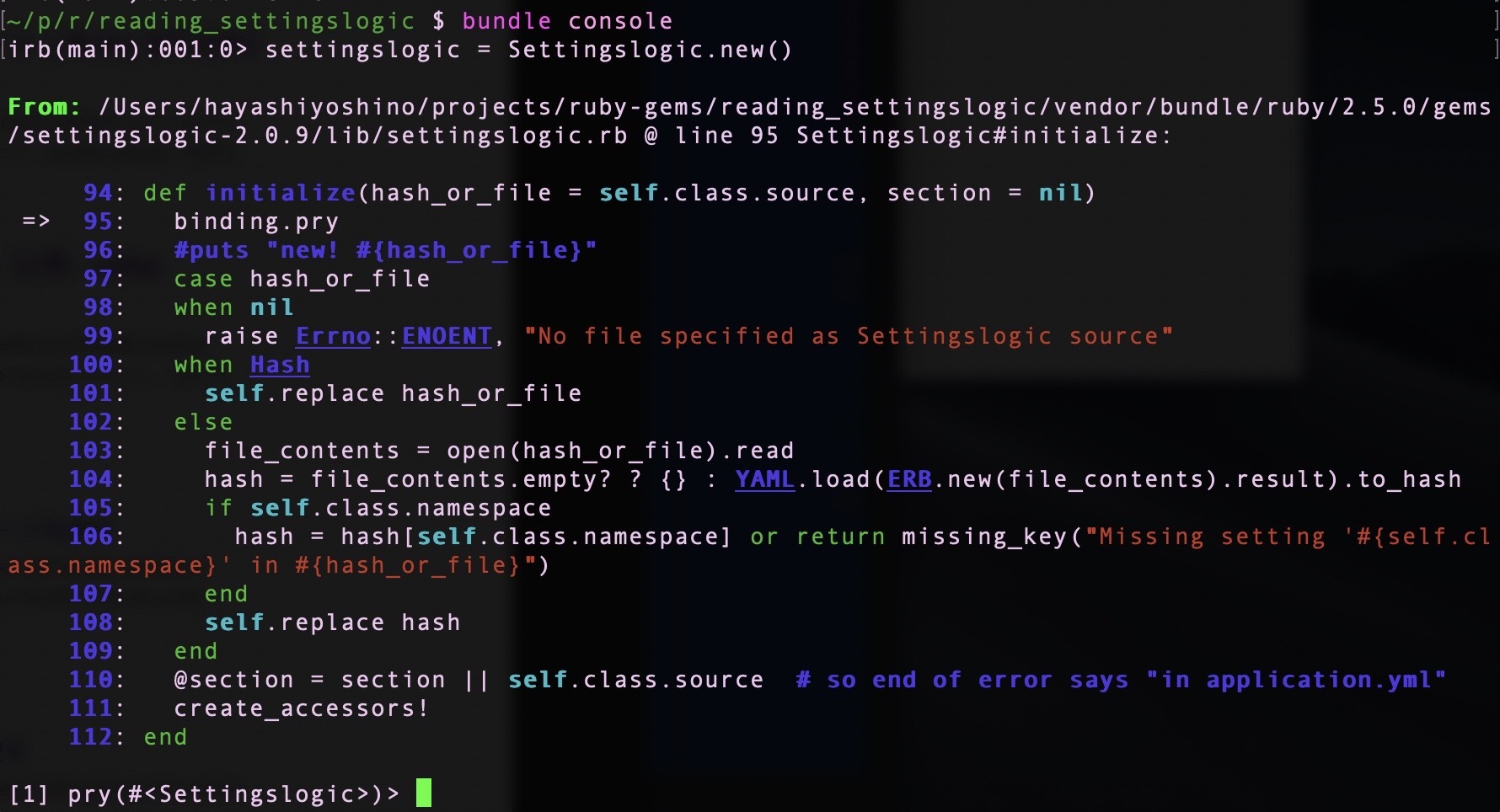settingslogicのコードリーディング
今日はsettingslogicのコードリーディングに混ぜていただきました!!
こちらの記事も参考にさせていただきました。
キモとなるコードはsettingslogic.rbというファイル1ページだけなものの、メタプロが結構出てきて難解です。
HackMDでそれぞれの気づきを共有しながら読み進めました。
全然読めなくて固まっていたのですが、教えてもらってなんとか少し読めたので、その内容について書き留めておこうと思います。
settingslogicの内容
ロジックはsettingslogic.rbというファイル1ページのみに書かれています。
settingslogic > lib > settingslogic.rb
require "yaml"
require "erb"
require 'open-uri'
# A simple settings solution using a YAML file. See README for more information.
class Settingslogic < Hash
class MissingSetting < StandardError; end
class << self
def name # :nodoc:
self.superclass != Hash && instance.key?("name") ? instance.name : super
end
# Enables Settings.get('nested.key.name') for dynamic access
def get(key)
parts = key.split('.')
curs = self
while p = parts.shift
curs = curs.send(p)
end
curs
end
def source(value = nil)
@source ||= value
end
def namespace(value = nil)
@namespace ||= value
end
def suppress_errors(value = nil)
@suppress_errors ||= value
end
def [](key)
instance.fetch(key.to_s, nil)
end
def []=(key, val)
# Setting[:key][:key2] = 'value' for dynamic settings
val = new(val, source) if val.is_a? Hash
instance.store(key.to_s, val)
instance.create_accessor_for(key, val)
end
def load!
instance
true
end
def reload!
@instance = nil
load!
end
private
def instance
return @instance if @instance
@instance = new
create_accessors!
@instance
end
def method_missing(name, *args, &block)
instance.send(name, *args, &block)
end
# It would be great to DRY this up somehow, someday, but it's difficult because
# of the singleton pattern. Basically this proxies Setting.foo to Setting.instance.foo
def create_accessors!
instance.each do |key,val|
create_accessor_for(key)
end
end
def create_accessor_for(key)
return unless key.to_s =~ /^\w+$/ # could have "some-setting:" which blows up eval
instance_eval "def #{key}; instance.send(:#{key}); end"
end
end
# Initializes a new settings object. You can initialize an object in any of the following ways:
#
# Settings.new(:application) # will look for config/application.yml
# Settings.new("application.yaml") # will look for application.yaml
# Settings.new("/var/configs/application.yml") # will look for /var/configs/application.yml
# Settings.new(:config1 => 1, :config2 => 2)
#
# Basically if you pass a symbol it will look for that file in the configs directory of your rails app,
# if you are using this in rails. If you pass a string it should be an absolute path to your settings file.
# Then you can pass a hash, and it just allows you to access the hash via methods.
def initialize(hash_or_file = self.class.source, section = nil)
#puts "new! #{hash_or_file}"
case hash_or_file
when nil
raise Errno::ENOENT, "No file specified as Settingslogic source"
when Hash
self.replace hash_or_file
else
file_contents = open(hash_or_file).read
hash = file_contents.empty? ? {} : YAML.load(ERB.new(file_contents).result).to_hash
if self.class.namespace
hash = hash[self.class.namespace] or return missing_key("Missing setting '#{self.class.namespace}' in #{hash_or_file}")
end
self.replace hash
end
@section = section || self.class.source # so end of error says "in application.yml"
create_accessors!
end
# Called for dynamically-defined keys, and also the first key deferenced at the top-level, if load! is not used.
# Otherwise, create_accessors! (called by new) will have created actual methods for each key.
def method_missing(name, *args, &block)
key = name.to_s
return missing_key("Missing setting '#{key}' in #{@section}") unless has_key? key
value = fetch(key)
create_accessor_for(key)
value.is_a?(Hash) ? self.class.new(value, "'#{key}' section in #{@section}") : value
end
def [](key)
fetch(key.to_s, nil)
end
def []=(key,val)
# Setting[:key][:key2] = 'value' for dynamic settings
val = self.class.new(val, @section) if val.is_a? Hash
store(key.to_s, val)
create_accessor_for(key, val)
end
# Returns an instance of a Hash object
def to_hash
Hash[self]
end
# This handles naming collisions with Sinatra/Vlad/Capistrano. Since these use a set()
# helper that defines methods in Object, ANY method_missing ANYWHERE picks up the Vlad/Sinatra
# settings! So settings.deploy_to title actually calls Object.deploy_to (from set :deploy_to, "host"),
# rather than the app_yml['deploy_to'] hash. Jeezus.
def create_accessors!
self.each do |key,val|
create_accessor_for(key)
end
end
# Use instance_eval/class_eval because they're actually more efficient than define_method{}
# http://stackoverflow.com/questions/185947/ruby-definemethod-vs-def
# http://bmorearty.wordpress.com/2009/01/09/fun-with-rubys-instance_eval-and-class_eval/
def create_accessor_for(key, val=nil)
return unless key.to_s =~ /^\w+$/ # could have "some-setting:" which blows up eval
instance_variable_set("@#{key}", val)
self.class.class_eval <<-EndEval
def #{key}
return @#{key} if @#{key}
return missing_key("Missing setting '#{key}' in #{@section}") unless has_key? '#{key}'
value = fetch('#{key}')
@#{key} = if value.is_a?(Hash)
self.class.new(value, "'#{key}' section in #{@section}")
elsif value.is_a?(Array) && value.all?{|v| v.is_a? Hash}
value.map{|v| self.class.new(v)}
else
value
end
end
EndEval
end
def symbolize_keys
inject({}) do |memo, tuple|
k = (tuple.first.to_sym rescue tuple.first) || tuple.first
v = k.is_a?(Symbol) ? send(k) : tuple.last # make sure the value is accessed the same way Settings.foo.bar works
memo[k] = v && v.respond_to?(:symbolize_keys) ? v.symbolize_keys : v #recurse for nested hashes
memo
end
end
def missing_key(msg)
return nil if self.class.suppress_errors
raise MissingSetting, msg
end
end
initializeされると、setting.rbファイルで定義した、
sourceの内容がhash_or_fileという変数に代入されます。
setting.rb
require './lib/settingslogic'
class Settings < Settingslogic
source "#{File.dirname(__FILE__)}/settings.yml"
end
hash_or_fileという変数の内容がnilの時は、
Errno::ENOENT, "No file specified as Settingslogic source"
が呼ばれます。
hash_or_fileがハッシュだった時は、selfを自身に置き換えます。
それ以外の時は何か複雑な処理が行われます。。。
わかったのはここまでです。。。
pryを活用したコードリーティングの進め方
①ディレクトリ作成し、そのディレクトリでbundle init を行います。
②作成されたGemfileにgem ‘settingslogic’とgem ‘pry’を書き加えます。
③bundle install —vendor/bundle を実行し、ディレクトリ内にgemをインストールします。
④gemの読みたい場所にbinding.pryを書き加えます。
⑤bundle console コマンドでコンソールを立ち上げ、変数の内容を確認したり、stepコマンドでメソッドの中を確認していきます。
⑥読み進めます。
pryを利用してみる
initializeメソッドの中にbinding.pryを置き、
bundle consoleで Settingslogic.new を実行してみます。
params メソッドでパラメーターをチェックしてみます。
stepメソッドも実行してみましたが、paramsメソッドの時となんだか同じ内容です。
「stepメソッドを実行すると、そのメソッドの定義されている場所に潜ることができる」と、調べたら書いてありましたが、いまいち使いこなせず。。。
selfも確認してみます。
んーーーー、、
pryを使いこなせませんでした。。。
pryは使いこなすと便利そうなので、積極的に使って練習していこうと思います。



